The traditional Buche de Noel, also known as the yule log cake, is a key French Christmas dessert. It’s a treat that looks great and doesn’t need fancy decorating skills. During the holidays, it’s a favorite, filled with chocolate cream and topped with mocha frosting made from dark chocolate chips.
This cake is inspired by the yule log tradition and looks festive. The sponge cake is light and spongy thanks to cake flour and whipped egg whites. After baking, it’s rolled warm, filled with whipped cream, and rolled up again.
It’s finished with mocha frosting, cranberries, and rosemary. This makes it look great and festive. In Parisian patisseries, it’s a big deal and shows off French holiday baking.
Key Takeaways
- The Buche de Noel, also known as yule log cake in America, is a staple French Christmas dessert.
- It’s designed to resemble a traditional yule log, embodying the essence of holiday warmth and cheer.
- The dessert consists of a chocolate sponge cake filled with chocolate cream and decorated with mocha frosting.
- The sponge cake’s light texture is attributed to the use of cake flour and softly whipped egg whites.
- Parisian patisseries celebrate this cake, making it a must-try during the holiday season.
Introduction to the Log Cake Tradition
The Yule log cake, or bûche de Noël, has a long history dating back to the 19th century. It’s especially loved in France, Belgium, and Luxembourg. But it has also won hearts in the United States, the United Kingdom, Portugal, and Japan. This cake is a key part of holiday traditions, filled with history and symbolism.
Understanding the Buche de Noel
The buche de Noel, also known as gateau de noel or gateau roule, pays tribute to the yule log. It’s a light genoise or sponge cake filled with rich chocolate buttercream. Decorated with berries, mushrooms, and powdered sugar, it looks like a snow-covered log.
History and Symbolism
In 19th-century France, the bûche de Noël became a symbol of the Yule log. Families would burn a real log in their fireplaces during Christmas. This tradition combines ancient rituals with modern celebrations, showing the cake’s lasting importance.
The cake’s design, with its bark-like texture and decorations, holds deep meaning. It stands for warmth, joy, and the spirit of the season.
| Ingredients for Classic Buche de Noel | Quantity |
|---|---|
| Genoise or Sponge Cake | 1 Cake Base |
| Egg Yolks (for Mocha Buttercream) | 5 Yolks |
| Butter (for Buttercream) | 1.5 Cups (3 Sticks) |
| Unsweetened Chocolate | 2 Ounces |
| Water (for Buttercream) | 1/2 Cup |
| Sugar (for Buttercream) | 1 1/4 Cups |
| Dark Chocolate (for Frosting) | 175g |
| Icing/Powdered Sugar | 250g |
| Butter (for Frosting) | 225g |
| Vanilla Extract | 1 Teaspoon |
The Origin of Buche de Noel
The Buche de Noel is a beloved holiday dessert with deep roots in tradition and culture. Its origin reveals a world of ancient practices that blend into today’s French holiday customs.
Ancient Traditions and Pagan Roots
The Buche de Noel comes from ancient traditions tied to the Winter Solstice. This ritual goes back to pagan Christmas celebrations, honoring the sun’s rebirth. People chose large logs, often from mystical oaks or elms, to burn. These logs were seen as a way to bring blessings and good luck, warming homes during the cold months.
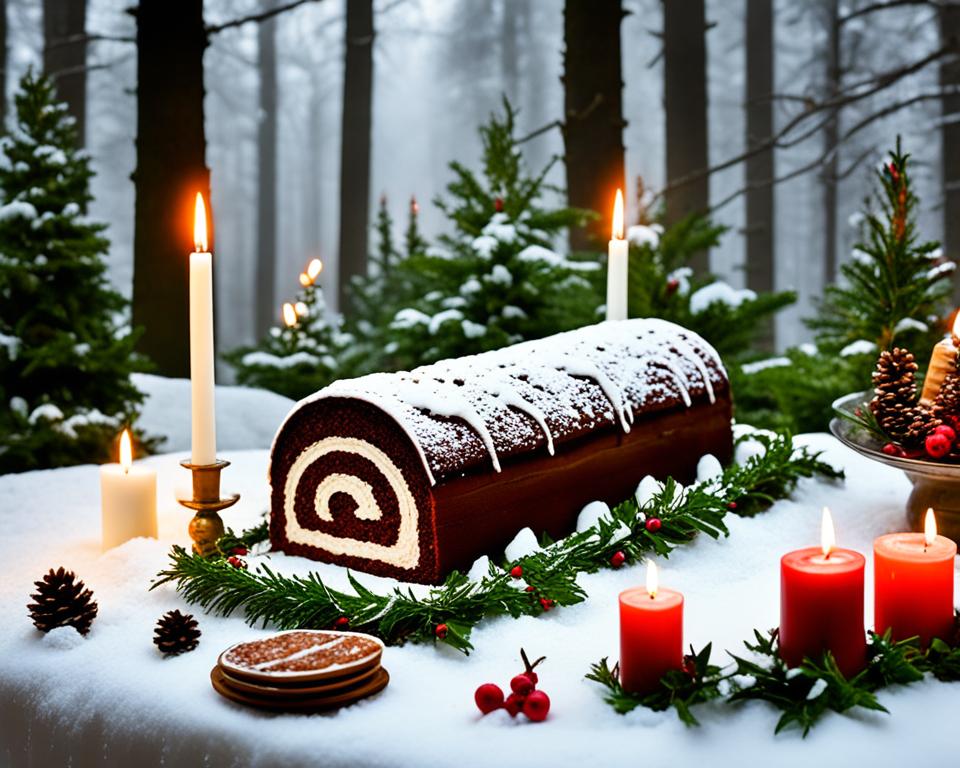
The Celtic Influence
Celtic traditions were key in shaping the Buche de Noel’s early customs. The Celts celebrated the Winter Solstice with fire rituals, welcoming the sun’s return. These practices merged with Christian symbols, keeping the tradition alive as it changed.
In medieval France, the tradition evolved into festive desserts for Christmas feasts. The Buche de Noel became a staple in French homes, blending Celtic and French customs. This change kept the tradition’s deep meaning while adding to the joy of family gatherings.
The Evolution of the Log Cake
The tradition of the “bûche de Noël” changed from a real log burned in the fireplace to a tasty Yule log cake. This change was influenced by history and culture. It mixed new cooking ideas with old traditions.
From Yule Log to Dessert
The Yule log cake started as a new idea in response to changing times. Families once burned a big log in the fireplace during the winter solstice. This log was meant to burn all night until Christmas Eve or even Epiphany day.
The wood type, often from fruit trees, showed its deep meaning. With Napoleon’s law, banning chimney use to stop disease spread, Parisian bakers saw an opportunity. They made a Yule log cake, decorated with holly and mushrooms, from a Swiss roll and buttercream.
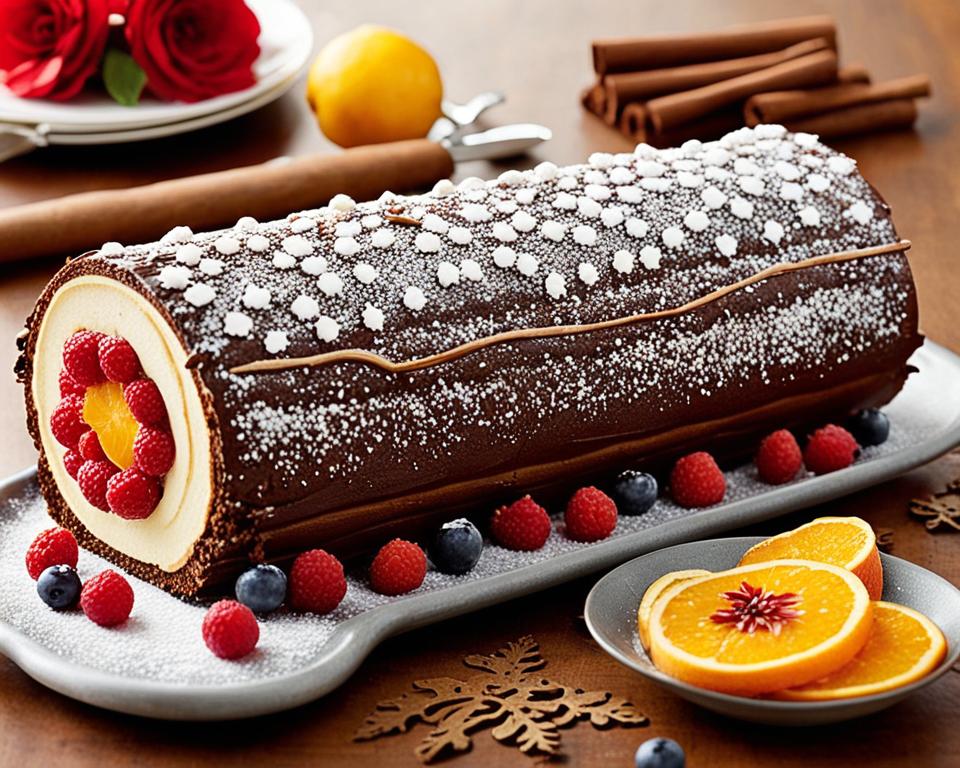
This cake fit smaller homes and became a hit on dinner tables. It was decorated with sweets, dried fruits, and cookies. Now, enjoying this cake is a key part of winter solstice celebrations, symbolizing warmth and being together.
Napoleon’s Influence and the Victorian Era
Napoleon’s laws helped turn the Yule log from a real log to a sweet dessert. This change was welcomed during the Victorian era, a time of love for rural life and traditions. The Victorians loved old customs but made them fit today’s world. The Yule log cake became a symbol of this, blending old and new.
The Victorians also brought new flavors like chocolate and mocha to the Yule log cake. This dessert became popular in Francophone countries and the U.S. in the 1960s. Now, it’s a beloved tradition with many modern twists.
The Yule log cake’s lasting appeal is its mix of old customs and new tastes. It turned a pre-Christian ritual of burning logs into a celebration of flavors and joy. This shows how the log cake tradition has evolved over time.
Ingredients and Typical Flavors
The Bûche de Noël is a classic French dessert. It combines traditional log cake ingredients with French dessert flavors. This holiday treat has a soft, airy cocoa sponge cake and tasty fillings. Each slice shows off the cake’s layers, making it perfect for family gatherings.
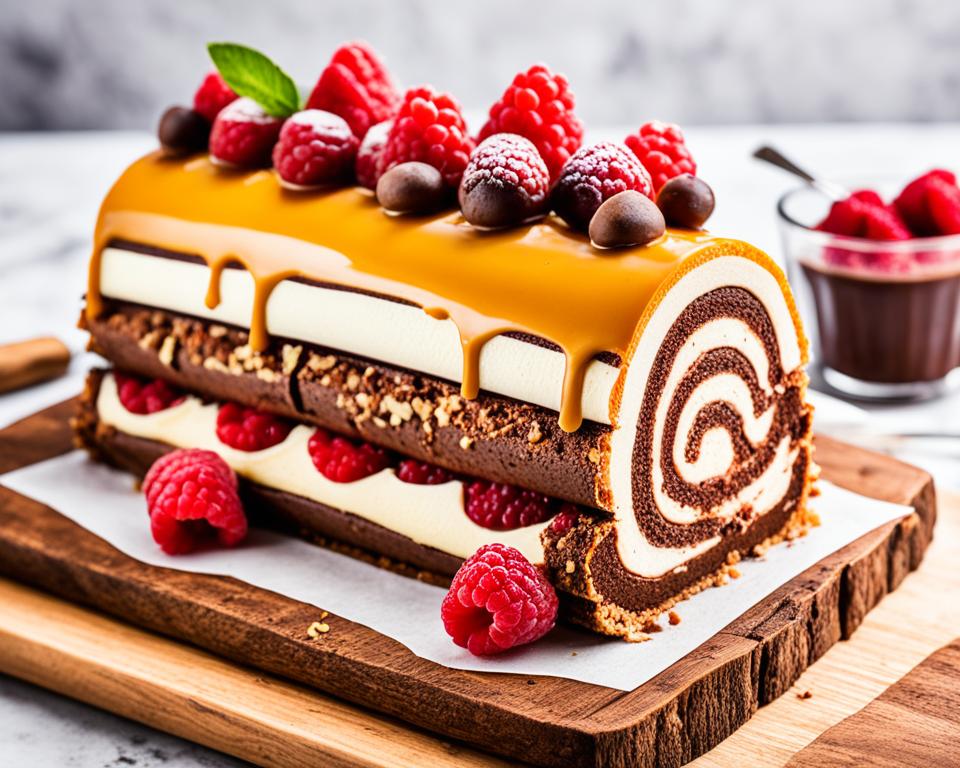
Classic Chocolate and Cream Variations
The classic Bûche de Noël is all about chocolate and cream. It starts with a sponge cake made from cake flour, unsweetened cocoa powder, and eggs. This gives it a light yet flavorful base.
Then, it gets creamy fillings like vanilla whipped cream or mascarpone. These add a luxurious touch. The richness of smooth chocolate ganache balances it all out.
- Cake Batter: 1 and 1/3 cups cake flour, 2 tablespoons unsweetened cocoa powder, 1 teaspoon baking powder, and 1/2 teaspoon salt.
- Filling: Heavy cream, confectioners’ sugar, and vanilla extract create the iconic vanilla whipped cream filling.
- Icing: Decadent chocolate ganache crafted from semi-sweet chocolate and heavy whipping cream.
Serving this dessert is a treat for the eyes and taste buds. The chocolate ganache coats the log cake. It harmonizes perfectly with the vanilla whipped cream filling.
Innovative Twists and Regional Variations
Today, chefs and bakers love to add new twists and regional flavors to the Bûche de Noël. While chocolate and cream are still popular, they also try new things. They use chestnut purée, exotic fruits, and local ingredients for a unique taste.
- Chestnut Purée: A rich and creamy filling often used in French patisseries.
- Fruity Experiments: Incorporating exotic fruits like passion fruit or mango for a refreshing twist.
- Local Flavors: Regional specialties might include raspberry mousse or caramelized apple fillings.
These new flavors keep the tradition alive. They also show how versatile this French dessert can be. Each log cake becomes a special culinary adventure.
Step-by-Step Recipe for a Perfect Log Cake
Starting your holiday baking with a Buche de Noël recipe is a joy. It’s a traditional French dessert that begins with dividing it into eight parts. This makes sure your DIY log cake turns out delicious with each step.
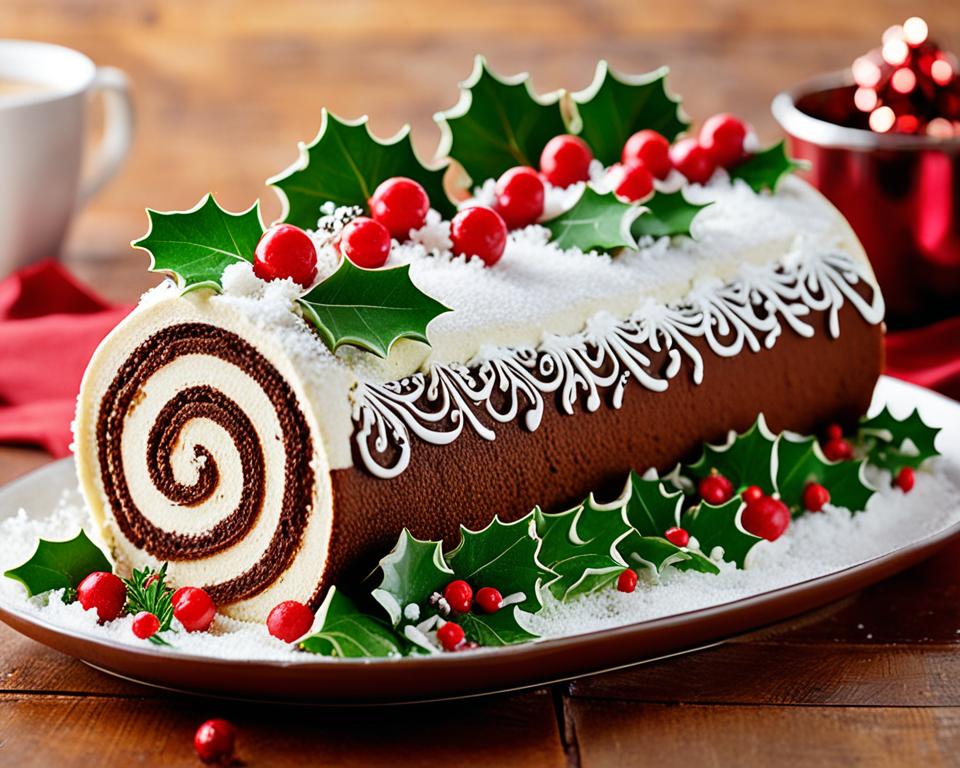
The Buche de Noël has six key parts: praline feuillete, crème brûlée, dacquoise biscuit, ganache, mousse, and glaze. Here’s a guide to help you prepare it over three days:
- Day 1: Make the praline feuillete and crème brûlée layers.
- Day 2: Bake the dacquoise biscuit and prepare the ganache.
- Day 3: Put together the mousse and glaze.
The dacquoise biscuit is a key part of the Buche de Noël. It takes just 10 minutes to prepare and 15 minutes to bake. You’ll need 80g of almond meal, 50g of confectioner’s sugar, 15g of all-purpose flour, 100ml of egg whites, and 50g of granulated sugar. It’s important to be precise, from mixing dry ingredients to getting a light cake.
Creating the mousse means whipping egg yolks with hot sugar syrup for a creamy texture. The ganache, with a 2:1 ratio of chocolate to hot cream, adds a rich layer to the cake.
When glazing, use twice the glaze and let it cool before applying. This ensures a smooth finish without clumps. Use acetate to line a half-pipe mold, layering the crème brûlée and ganache in the mousse for a perfect look.
For the final touch, press the layers together carefully. Freeze the cake to keep its shape, ready for clean slices. The result is a light, airy French Yule Log that looks and tastes amazing.
This guide to holiday baking honors a French tradition. Each step is crucial for a beautiful and delicious DIY log cake to impress at any holiday party.
| Component | Preparation | Ingredients |
|---|---|---|
| Praline Feuillete | Day 1 | – |
| Crème Brûlée | Day 1 | – |
| Dacquoise Biscuit | Day 2 | Almond meal, confectioner’s sugar, flour, egg whites, granulated sugar |
| Ganache | Day 2 | Dark chocolate, cream |
| Mousse | Day 3 | Egg yolks, hot sugar syrup |
| Glaze | Day 3 | – |
The Art of Log Cake Decoration
Decoration turns the log cake into a stunning centerpiece. It’s not just about making it taste good, but also looking amazing. The art of log cake decoration combines art and science. It makes the cake both beautiful and delicious.
Using Mocha Frosting for Realistic Effects
Creating a Bûche de Noël is all about the mocha frosting. This frosting, made with dark chocolate and espresso, looks like tree bark. Here’s how to get that look:
- Put a thin layer of mocha frosting on the cake and chill it.
- Add a thicker layer of frosting, score it with a fork for bark texture.
- Then, sprinkle powdered sugar on top to look like snow.
These steps make the holiday cake presentation look great. They also add a coffee flavor that balances the sweetness.
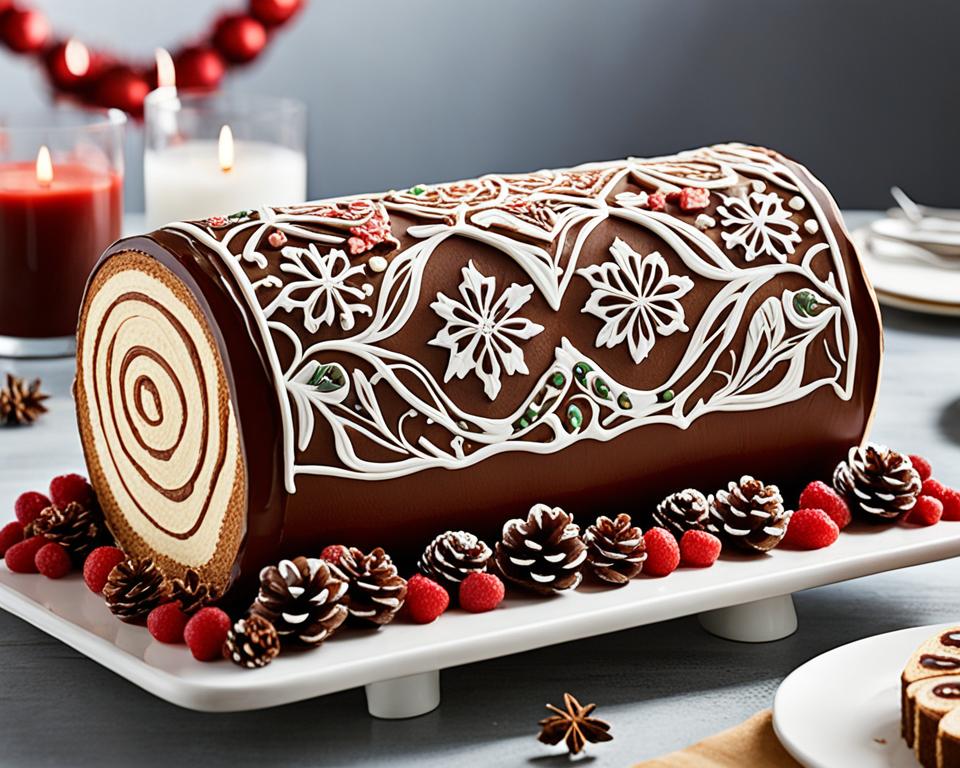
Garnishing with Cranberries and Rosemary
Adding festive garnishing makes the log cake look even better. Cranberries and rosemary are great choices. They add color and a nice smell. Here’s what to do:
- Line the cake with fresh cranberries for a pop of red.
- Use rosemary sprigs to look like pine needles, adding to the forest feel.
- Think about adding marzipan holly leaves and meringue mushrooms for more holiday charm.
Pay attention to these details for a holiday cake presentation that’s unforgettable. It captures the holiday spirit in taste and look.
Where to Find Authentic Log Cake France Creations
Paris and France are full of patisseries where you can try the famous Buche de Noel. You’ll find top Parisian log cake shops and France’s regional patisseries with artisanal treats. These places offer an authentic taste filled with tradition. Whether in Paris’s glamorous streets or regional towns, these bakeries tell a story of pastry perfection.
Best Patisseries in Paris
For the best Parisian log cake shops, check out Lenôtre. Chefs Guy Krenzer and Guy Melot have made a forest-inspired Yule log. It’s filled with chocolate biscuit roulé, crunchy praline, and chocolate brown sugar.
Another spot is Yann Couvreur’s patisserie, with their “Chilling Christmas” Yule log. It’s a mix of crispy cazette, chestnut biscuit, and chestnut honey. Plus, there’s creamy caramel, chestnut mousse, and candied chestnuts.
Jeffrey Cagnes at Stohrer offers a traditional king cake with almond flavor. Guy Martin at Grand Véfour has a version with salted caramel and cashew nut cream. And don’t miss Fauchon’s unique cake with chocolate milk and fleur de sel bread.
Renowned Bakeries Across France
Outside of Paris, France is full of patisseries with amazing Buche de Noel. Chefs like Julien Alvarez at Ladurée and Pierre Hermé keep the tradition alive. Ladurée’s Yule log is available in France, the US, UK, and Canada. Pierre Hermé’s creations are also found internationally, making gourmet holiday desserts easy to find.
You can try Yule logs by Cedric Grolet in the UK or Yann Couvreur in France, the US, and Korea. France’s regional patisseries offer a wide range of quality treats. For a special holiday, enjoying desserts from the world’s top patissiers is unforgettable.
The Significance of the Log Cake in French Culture
The log cake, or bûche de Noël, is more than just a dessert in French holiday traditions. It’s a key part of Christmas in France. It symbolizes warmth, unity, and the joy of festive celebrations.
Long ago, the yule log was a real log burned for protection during the holidays. As fireplaces got smaller, the log cake became a sweet treat. The first recipe, by Pierre Lacam in 1890, was for a sponge cake filled with buttercream, just like the original log.
By the late 1800s, the bûche de Noël was a hit in Paris with the upper class. It showed off their love for fine taste and French cooking. Today, patisseries and luxury hotels, like Valrhona, create amazing log cakes. They mix new flavors and designs.
Now, pastry shops offer many log cake types, mixing old and new ideas. These cakes symbolize plenty and luck, just like before. Their mix of history and new tastes keeps the log cake a big deal in French culture, loved during the holidays.
Log Cake France – A Delightful Holiday Experience
Experience the magic of the holiday season in France with the Buche de Noel. This classic French pastry has been a Christmas tradition since at least 1615. It’s known for its rich chocolate taste and beautiful decorations.
In the 19th century, Parisian bakers made the Buche de Noel a true work of art. They showed off their creations in shop windows, turning this simple dessert into a symbol of French holiday joy.
Eating a Buche de Noel is more than just tasting something sweet. Making this cake is a celebration of French skill. It uses eggs, sugar, flour, cocoa powder, double cream, and icing sugar for a masterpiece. The recipe takes just 10 minutes to bake, giving you about 12 slices of joy. For the best taste, eat it within three days if you keep it in the fridge.
Winter in Paris isn’t complete without trying festive French pastries like the Buche de Noel. This dessert shows off France’s love for elegant celebrations. Enjoy it in a cozy home or a fancy Parisian café, and it will make the holiday season sweeter.
During the holidays, people love the Buche de Noël even more, with sales going up by up to 30%. Traditional Buche de Noël cakes make up over 60% of Christmas desserts sold in French bakeries. New flavors and decorations have also become popular, making the dessert even more exciting.
About 45% of French families make their own Buche de Noël. This tradition is a way to celebrate the holiday season. When you enjoy this French chocolate Christmas cake, you’re joining a long-standing tradition that brings joy and warmth during the cold winter months.
Conclusion
Our journey into the Buche de Noel shows how deeply this dessert is part of French traditions. It has a rich history from the 19th century in France. It’s more than just a dessert; it’s a celebration of festive joy and culinary art.
Enjoying Buche de Noel is a treat for both the eyes and taste buds. Its intricate decorations and rich chocolate and cream flavors show the skill of French patisseries. Desserts like La Levain’s Kaffee Buche are famous for their quality and unique flavors.
La Levain’s Christmas Artisan Bakes 2023 show how this dessert keeps evolving while staying true to tradition. The FOOD BLOGGERS AND FOODIES UNITED FACEBOOK GROUP and over 2,600 recipes on the FOOD BLOGGERS AND FOODIES UNITED PINTEREST highlight the community’s love for this holiday treat.
The Buche de Noel is a symbol of French baking excellence. It captures the holiday spirit and elegance. This season, try making a homemade chocolate Yule log or enjoy a premium French Buche de Noel. Let the flavors and aromas bring joy to your table.
Source Links
- https://www.monpetitfour.com/buche-de-noel/
- https://zoebakes.com/2018/12/13/buche-de-noel-christmas-yule-log/
- https://www.internationaldessertsblog.com/buche-de-noel-tutorial-french-yule-log-cake/
- https://en.wikipedia.org/wiki/Yule_log_(cake)
- https://www.twelvedays.com/blogs/news/7020130-buche-de-noel-aka-fancy-french-log-cake
- https://www.instructables.com/Yule-Log-Cake/
- https://frenchly.us/beyond-brioche-la-buche-de-noel/
- https://hillstreetgrocer.com/featured-content/articles/la-buche-de-noel-christmas-tradition
- https://www.couleurnature.com/blogs/news/the-buche-de-noel-a-french-christmas-tradition
- https://zestoffrance.com/origin-and-tradition-of-yule-log-cake/
- https://france-amerique.com/yule-log-a-french-dessert-devoured-abroad/
- https://www.unculturedpalate.com/this-food-in-history/this-food-in-history-7-yule-log
- https://sallysbakingaddiction.com/buche-de-noel-yule-log/
- https://www.allrecipes.com/recipe/17345/buche-de-noel/
- https://www.lifeloveandsugar.com/yule-log-cake-buche-de-noel/
- https://userealbutter.com/2008/12/28/french-yule-log-cake-recipe/
- https://minetterushing.com/classic-buche-de-noel-recipe-yule-log-cake/
- https://www.sprinklebakes.com/2009/12/step-by-step-buche-de-noel-or-yule-log.html
- https://www.cuisineathome.com/how-to/how-to-make-a-buche-de-noel-yule-log-cake/
- https://www.elisabethandbutter.com/blog/buche-de-noel
- https://thecookandthewriter.com/2018/12/25/buche-de-noel-a-yule-log-cake/
- https://www.clerhotel.com/en/blog/yule-logs-and-king-cakes-at-epiphany-195871
- https://www.tastefrance.com/magazine/article/best-french-yule-logs-2023
- http://bakingwithjulie.com/buche-de-noel-yule-log-cake/
- https://www.nationalgeographic.com/travel/article/what-is-yule-log-christmas-dessert
- https://www.valrhona-collection.ae/en/yule-log-cake
- https://www.simplefrenchcooking.com/recipe-entry/a-french-christmas-yule-log
- https://larderlove.com/buche-de-noel-yule-log-cake/
- https://www.littlepassports.com/blog/world-holidays/france-christmas-tradition/
- https://kwgls.wordpress.com/2014/11/22/preparing-your-own-log-cake-chocolate-yule-log-cake-with-coffee-cream-bche-de-nol-巧克力树桐蛋糕)/
- https://www.lalevain.com/a-forest-of-flavours-log-cakes/
- https://www.travelfranceonline.com/yule-log-french-buche-de-noel-recipe/

